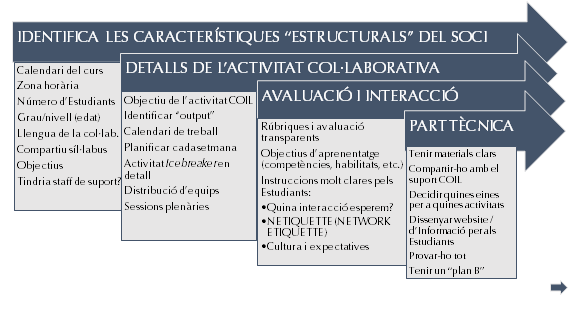
This is the teacher's room, where you will find all the necessary information and contact details if you want to do a COIL or a related training course.
COIL basic structure
It is recommended that the duration of COIL be between 5 and 12 weeks. Less than 4 is not fruitful due to lack of time.
Likewise, it is always advisable to leave one or two weeks of margin in case it is appropriate to extend it. Flexibility and adaptability are also key in the COIL structure.
Although the central element of COIL is the student's learning, not only academically but also in terms of competences such as intercultural communication, teamwork or digital competence, COIL is a methodology that absolutely depends on the teacher
In this sense, it is vital that the task to be carried out is well designed, with sufficient time, and all the details to be taken into account in the planning phase are collected. Once the collaboration between students begins, time passes very quickly and you need to have everything well thought out beforehand.
If you are a teacher and you are interested in doing COIL, contact coil@urv.cat for more information!

Training courses

The COIL coordination at the URV promotes the training of teachers so that they can implement this methodology in their classroom.
Courses offered so far (within the URV):
- PROFI121: COIL: Oportunitats de l'aprenentatge internacional en línia
- PROFI122: Workshop: Com implementar el COIL a l'aula
- 01IN0001: Using Collaborative On-line International Learning (COIL) to open students' minds, and demonstrating scientifically (BEVI) that it works!
- 01IN0002: The Power and Potential of Collaborative Online International Learning: Why and How to Develop, Implement, and Evaluate COIL-Based Courses and Programs
- 01IT0008-1: Com gestionar la comunicació intercultural a l'aula?
- 01DO0004-1: Fonaments, disseny i desenvolupament del COIL: eines per a la implementació a la teva aula (2020)
- 01DO0004-1: Fonaments, disseny i desenvolupament del COIL: eines per a la implementació a la teva aula (2021)
The COIL coordination is also part of several international networks and groups and we have participated in several congresses.
Accreditation
The International Center and the ICE are working to consolidate the recognition of teachers who carry out COIL in their classrooms.At the moment, all COIL activities receive a certificate for the students and for the teaching staff involved in order to be able to generate future accreditation.
Materials and resources: Virtual Campus

In the Virtual Campus there is a COIL working group where we have materials, examples, websites of interest and procedural documents that can be very useful when designing and implementing a COIL.
Contact us if you are interested in being part of it! coil@urv.cat
Guidelines for teaching collaboration
Although the central element of COIL is the student's learning, not only academically but also in terms of competences such as intercultural communication, teamwork or digital competence, COIL is a methodology that absolutely depends on the teacher.
In this sense, it is vital that the task to be carried out is well designed, with sufficient time, and all the details to be taken into account in the planning phase are collected.
Once the collaboration between students begins, time passes very quickly and you need to have everything well thought out beforehand.
In the "checklist" document (Catalan and English versions) you will find a guideline for the development of teaching collaboration that can serve as a guide and to "mark" all the necessary decisions that you need to be clear about before collaboration between students begins. Briefly, it includes:

- Checklist for teacher collaboration (català)
- Checklist for teacher collaboration (anglès)
Guidelines for student collaboration
- It is essential to design an icebreaker activity to break the ice at the beginning and generate a space of trust for collaboration.
- Create a space where they can find all the necessary information: activity objectives, rubrics, calendars, skills, etc. This can be a specific website, a padlet, a google drive, combine and reinforce it in moodle itself, communicate via slack, etc.
- Create a space where collaboration and interaction is possible between them. See the resources section for more information on platforms, tools and websites.
- Establish in advance the rules of conduct: respect, punctuality, cordiality…
- Follow up on cross-cultural interaction. Working in a team is not always easy, if the team is also multicultural there may be some communication problem that the teachers can help solve.
- It is advisable to do a preliminary and final survey to see the evolution and learning and to consolidate the lived experience.
Remember!
- It is necessary to have all the information clear and informed before starting the activity.
- Send a pre-questionnaire to the students, do some introduction about the activity in the URV classroom.
- Submit image assignment document (if applicable).
- Schedule an initial plenary session (if it can be synchronous). Explain in it:
- A little information about the two institutions.
- The website or space where students will find all the information.
- The tasks they will have to do.
- Calendar.
- Evaluation.
- Don't forget to emphasize that you must be polite and respectful towards the activity and your colleagues.
- Track activity while it lasts.
- Schedule a final plenary session to assess content and experience.
- Submit a final questionnaire.
- Record videos, images, etc.
